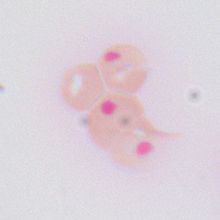Heinz body
Heinz bodies (syn. Heinz inner bodies, Heinz Ehrlich bodies, Heinz blue bodies) are microscopically visible clumps of the red blood pigment ( hemoglobin ) in the red blood cells ( erythrocytes ). This leads to an oxidative denaturation of this protein . This altered hemoglobin forms clumps (aggregates) that attach to the inner cell membrane of the erythrocytes.
Heinz bodies lead to direct damage to the erythrocytes and reduce their lifespan, as the changed erythrocytes in the spleen are secreted and broken down. Cats are an exception , since their spleen is apparently unable to eliminate erythrocytes with Heinz bodies. In cats, therefore, Heinz bodies are not always associated with hemolytic anemia and a certain proportion of erythrocytes in the blood that have been changed in this way are physiological.
Occurrence
Heinz bodies occur in cases of poisoning with all nitro and aniline derivatives , enzyme defects of the erythrocytes (e.g. glucose-6-phosphate dehydrogenase deficiency ), α-thalassemia and hemoglobinopathies (e.g. hemoglobin Cologne disease).
Individual evidence
- ↑ Baron CP, Andersen HJ: Myoglobin-induced lipid oxidation. A review . In: J. Agric. Food Chem . 50, No. 14, July 2002, pp. 3887-97. PMID 12083855 .
- ↑ Rifkind JM, Abugo O, Levy A, Heim J: Detection, formation, and relevance of hemichromes and hemochromes . In: Meth. Enzymol. . 231, 1994, pp. 449-80. PMID 8041268 .
